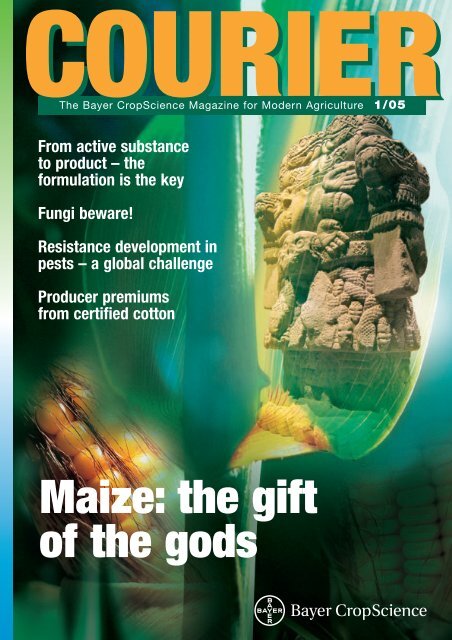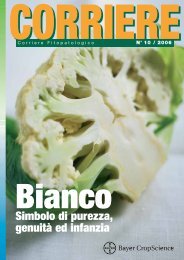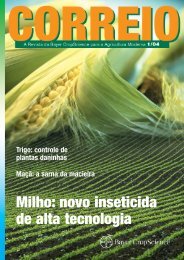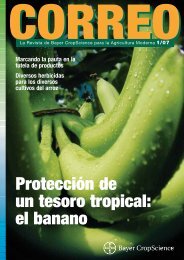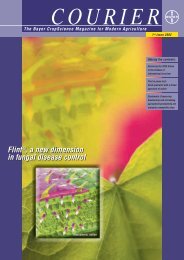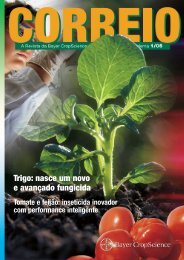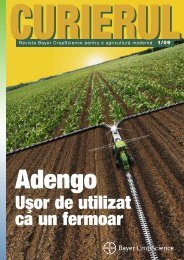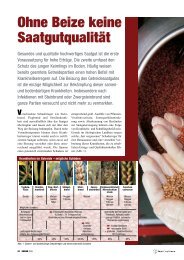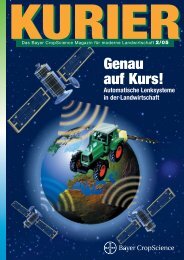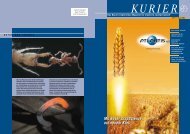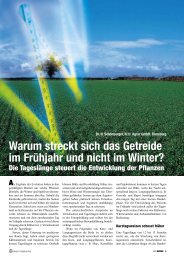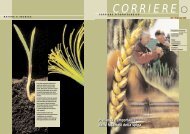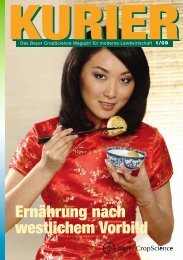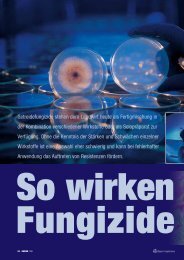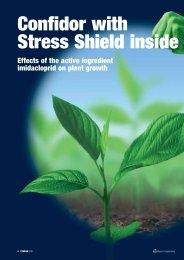Maize: the gift of the gods
Maize: the gift of the gods
Maize: the gift of the gods
- No tags were found...
You also want an ePaper? Increase the reach of your titles
YUMPU automatically turns print PDFs into web optimized ePapers that Google loves.
COURIERThe Bayer CropScience Magazine for Modern Agriculture 1/05From active substanceto product – <strong>the</strong>formulation is <strong>the</strong> keyFungi beware!Resistance development inpests – a global challengeProducer premiumsfrom certified cotton<strong>Maize</strong>: <strong>the</strong> <strong>gift</strong><strong>of</strong> <strong>the</strong> <strong>gods</strong>
Contents3 <strong>Maize</strong>: <strong>the</strong> <strong>gift</strong> <strong>of</strong> <strong>the</strong> <strong>gods</strong>6 From active substanceto product – <strong>the</strong> formulationis <strong>the</strong> key10 Fungi beware!Dialogue with customers– <strong>the</strong> Online Magazineextends opportunities for<strong>the</strong> reader13 A “Typhoon” that blows outfungal infection14 Joining forces against Fusarium– Bayer CropScience organizesan international Symposium17 Resistance development inpests – a global challenge20 Producer premiums fromcertified cottonPublished by: Bayer CropScience AG, Monheim / Editor:Bernhard Grupp / With contributions from: R. Audige, K.-U.Brüggen, D. Eck, P. Krewer, C. Leveque, A. Röchling, S.Rudolph (periodista independiente), R. Vermeer / Designand Layout: Xpertise, Langenfeld / Lithography: LetternserviceDüsseldorf GmbH, Düsseldorf / Printed by: Broermann,Troisdorf / Reproduction <strong>of</strong> contents is permissibleproviding Bayer is acknowledged and advised by specimencopy / Editor’s address: Bayer CropScience AG, CorporateCommunications, Alfred-Nobel-Str. 50, 40789 Monheimam Rhein, Germany, FAX: 0049-2173-383454 / Website:www.bayercropscience.comForward-Looking StatementsThis news release contains forward-looking statementsbased on current assumptions and forecasts made byBayer CropScience AG management. Various known andunknown risks, uncertainties and o<strong>the</strong>r factors could leadto material differences between <strong>the</strong> actual future results,financial situation, development or performance <strong>of</strong> <strong>the</strong>Bayer CropScience AG or our parent company, Bayer AG,and <strong>the</strong> estimates given here. These factors include thosediscussed in Bayer AG's public reports filed with <strong>the</strong> FrankfurtStock Exchange and with <strong>the</strong> U.S. Securities andExchange Commission (including Bayer AG's Form 20-F).Nei<strong>the</strong>r Bayer AG nor Bayer CropScience AG assumes anyliability whatsoever to update <strong>the</strong>se forward-looking statementsor to conform <strong>the</strong>m to future events or developments.Publishing articles on <strong>the</strong> internet presentsspecial challenges to authors and journalists.Internet text must be short and concise,put toge<strong>the</strong>r in a modular way,arranged in sections under informativeheadings, and peppered with hyperlinks toprovide routes to fur<strong>the</strong>r information. Thereader is presented with a summary <strong>of</strong> <strong>the</strong>most relevant points, and can decide forhimself how much he wants to read abouta particular subject.This is what distinguishes an onlinemagazine from a printed publication.Hyperlinks make it possible to refer to <strong>the</strong>background information on related topicsthat is already available on <strong>the</strong> internet. Soinstead <strong>of</strong> summarizing <strong>the</strong> same backgroundinformation in every article, anindication can be given as to where to findit in previous articles or a link can be providedto extensive background informationelsewhere.The online edition <strong>of</strong> Courier hasbecome a pretty useful resource for <strong>the</strong>many farmers, advisors and traders aroundfrom <strong>the</strong> world who regularly seek information.Its interactivity – direct contactbetween authors, editors and <strong>the</strong> reader -<strong>of</strong>fers new possibilities for communication:email exchanges, obtaining <strong>the</strong> verylatest information, or direct access to <strong>the</strong>archive.For example, old editions that have longbeen unavailable in <strong>the</strong>ir printed form canbe printed out at <strong>the</strong> user’s desk: only a fewmouse-clicks are needed. The quick-searchfunction allows direct access to a wealth <strong>of</strong>information that <strong>the</strong> printed edition alonecould never match. The online editionallows <strong>the</strong> reader to search, choose andorganise <strong>the</strong> information spontaneouslyand independently.Actually, it is <strong>the</strong> combination <strong>of</strong> <strong>the</strong>printed and online editions that <strong>of</strong>fers <strong>the</strong>greatest advantage to <strong>the</strong> reader. Ins<strong>of</strong>ar as<strong>the</strong>y complement each o<strong>the</strong>r, ra<strong>the</strong>r thancompete with or contradict each o<strong>the</strong>r, <strong>the</strong>customer is king, and is free to choose.The numerous queries we receive viaour customer magazine’s internet sitestreng<strong>the</strong>n our confidence that our readersrespond to, and pr<strong>of</strong>it from, <strong>the</strong> dialoguewe create. Fur<strong>the</strong>r support for this comesfrom <strong>the</strong> steadily increasing number <strong>of</strong> hitswe have been receiving since <strong>the</strong> onlineedition <strong>of</strong> Courier started. And this is whatmotivates us in our work: being an attractivecustomer magazine for modern agriculture.■2 COURIER 1/05
<strong>Maize</strong>: <strong>the</strong> <strong>gift</strong><strong>of</strong> <strong>the</strong> <strong>gods</strong>IntroductionMain producers <strong>of</strong> maize worldwide<strong>Maize</strong> (Zea mays L.) occupies thirdplace in world production as a source <strong>of</strong>food, forage, and processed products forindustry. It is one <strong>of</strong> <strong>the</strong> plants most frequentlystudied by scientists because <strong>of</strong> itsgreat adaptability to climates and regions,<strong>the</strong> high level <strong>of</strong> mutation it naturally possessesand <strong>the</strong> relative ease with which itcan be crossed and hybridized. It is <strong>the</strong>only cereal from <strong>the</strong> New World which,because <strong>of</strong> its productivity and adaptability,spread rapidly to practically <strong>the</strong> entireworld after <strong>the</strong> Spaniards brought it toEurope.In 2004, approximately 704 milliontonnes <strong>of</strong> this grain were produced worldwide,mainly in <strong>the</strong> United States, China,United StatesChinaBrazilMexicoRest <strong>of</strong> <strong>the</strong> worldSource: FAO, 2004.Brazil and Mexico, which toge<strong>the</strong>r suppliedabout 70 percent <strong>of</strong> world output.Most <strong>of</strong> global output is intended forforage and for <strong>the</strong> manufacture <strong>of</strong> industrialproducts such as oils and starches,among o<strong>the</strong>rs; varieties to be eaten fresh oras popcorn can be found to a lesser extent.1/05 COURIER 3
What happens to maize output worldwide<strong>Maize</strong> is <strong>the</strong> most domesticated andmost highly developed plant in <strong>the</strong> entirevegetable kingdom today. Its origin anddevelopment are a mystery. Unlike o<strong>the</strong>rcereals, which have natural wild varieties,maize is known only through <strong>the</strong> cultivatedspecies. Because <strong>of</strong> this, various <strong>the</strong>orieshave been advanced since <strong>the</strong> last centuryto explain its origin and development; <strong>the</strong>most popular <strong>the</strong>ory accepts Chalcoteocintle in Mexico (Zea mays sp. mexicana)as its direct ancestor.History<strong>Maize</strong> came originally from America;in Mexico it was grown embryonically8,000 years ago, and it has been completelydomesticated for over 6,000 years.Its relationship with man has been suchthat it is now a plant which cannot reproducewithout human involvement, so, ifpeople stopped growing it, it would disappear.Industry and livestockFoodPopcornSource: IMSA, Mexico 2004.Mexico is well known for <strong>the</strong> Olmeca,Maya, Teotihuacána, Aztec and Purépechacultures, among o<strong>the</strong>rs, which, for <strong>the</strong>irflowering and development as civilisations,shared maize as <strong>the</strong>ir common basis,since foods and beverages (more than 605different dishes are known), fertilisers, fuelfor <strong>the</strong> hearth, medicinal extracts (aloneand in combination with o<strong>the</strong>r plants) wereobtained from it, and are still beingobtained today. Its seeds were used for predictionrituals and for <strong>the</strong> production <strong>of</strong>utensils and artefacts.For <strong>the</strong> Aztecs, <strong>the</strong> creation <strong>of</strong> man was<strong>the</strong> work <strong>of</strong> two <strong>gods</strong>, Quetzalcoatl andTezcatlipoca. These <strong>gods</strong>, locked in constantstruggle, formed <strong>the</strong> history <strong>of</strong> <strong>the</strong>universe. It is said that on one occasionQuetzalcoatl stole <strong>the</strong> “bone <strong>of</strong> preciousstone”, which was in <strong>the</strong> underworld andgave it to <strong>the</strong> goddess Ciuacoatl, whoground it on a flat grinding stone fromwhich she obtained a flour which, whenmixed with <strong>the</strong> blood <strong>of</strong> <strong>the</strong>se <strong>gods</strong>, gaverise to man; Quetzalcoatl later gave her <strong>the</strong>maize which was hidden in a cave so shecould survive.To venerate such a precious <strong>gift</strong>, a god<strong>of</strong> maize was created whose name wasCentéotl. This peculiar god did not dominateany element nor did he appear among<strong>the</strong> greatest; he was simply maize, <strong>the</strong>cereal which gave <strong>the</strong> largest yield, survivedplagues and frosts and could grow in<strong>the</strong> widest variety <strong>of</strong> climates.Later, during <strong>the</strong> Conquest, <strong>the</strong>Spaniards demanded that o<strong>the</strong>r cereals begrown; although <strong>the</strong>y found that maize wasexcellent forage for animals, it was at thattime considered a cereal <strong>of</strong> inferior qualityfit only for animals and slaves.As mentioned in a Huichol legend, differentcolours <strong>of</strong> maize exist: <strong>the</strong> Mo<strong>the</strong>r<strong>of</strong> <strong>Maize</strong> changed her shape from that <strong>of</strong> adove and adopted human form; she presentedher five daughters, who symbolise<strong>the</strong> five sacred colours <strong>of</strong> maize – white,red, yellow, speckled and blue – to <strong>the</strong> boy.As Man was hungry, <strong>the</strong> Mo<strong>the</strong>r <strong>of</strong> <strong>Maize</strong>gave him a pot full <strong>of</strong> tortillas and a gourd(recipient) full <strong>of</strong> atole (a cornflour drink);he did not believe that this could satisfy hishunger, but <strong>the</strong> supply <strong>of</strong> tortillas and atolekept being replenished by magic. This legendtalks about <strong>the</strong> colours <strong>of</strong> maize; <strong>the</strong>seexist even today. Source: The book, “Mitosy arte Huicholes” (Huichol myths and art).<strong>Maize</strong> currently accounts for almosthalf <strong>the</strong> total volume <strong>of</strong> food consumedevery year in Mexico. According to <strong>of</strong>ficialdata, approximately 300 million tortillasare eaten every day (prepared in largequantities by machinery or else by housewivesin many parts <strong>of</strong> <strong>the</strong> country, especiallyin rural areas, where it is a daily task)and this is why <strong>the</strong>y say: “<strong>Maize</strong>, society,culture and history are inseparable. Ourpast and our present are based on maize.Our life is based on maize. We are maizepeople”. (Guillermo Bonfil Batalla: Elmaiz, fundamento de la cultura mexicana[<strong>Maize</strong>, <strong>the</strong> basis <strong>of</strong> Mexican culture].1982).Bayer CropScience: Protectingmaize – <strong>the</strong> most precious <strong>gift</strong><strong>of</strong> <strong>the</strong> <strong>gods</strong>In Mexico, between 7 and 8.4 millionhectares <strong>of</strong> maize are sown every yearthroughout <strong>the</strong> length and breadth <strong>of</strong> <strong>the</strong>country; <strong>the</strong>re are three kinds <strong>of</strong> farmer:• The small-scale farmer: low-tech, with 1to 3 hectares on average, for his own con-4 COURIER 1/05
Western corn rootworm (Diabrotica virgifera)June beetle larvae (Phyllophaga spp.)Armyworm (Spodoptera frugiperda)sumption. Has <strong>the</strong> lowest yields, 1.92tonnes/ha*.• The average farmer: medium- to hightech,with 5 to 50 hectares on average.Has yields <strong>of</strong> 5.79 tonnes/ha.*• The large-scale farmer: medium- andvery high-tech, with over 50 ha and withyields <strong>of</strong> 7.5 tonnes/ha.*Like o<strong>the</strong>r crops, maize has to face aseries <strong>of</strong> plant protection problems whichnecessitate <strong>the</strong> use <strong>of</strong> highly efficaciousproducts. Bayer CropScience <strong>of</strong>fers farmersa wide range <strong>of</strong> solutions to <strong>the</strong>se problems.The main problems <strong>of</strong> maize in Mexicocan be classified as: soil pests, foliagepests, and weeds.Soil pestsAfter sowing, maize at its initial stagehas to face attacks from various pests,including white grubs (Phyllophaga spp.),wireworms (Melanotus spp.), and cornrootworms (Diabrotica spp.), which causeserious losses as <strong>the</strong>y feed directly on <strong>the</strong>roots. Azteca ® 2g and Mocap ® 15g areinsecticides which control <strong>the</strong>se pestseffectively.This year, Poncho ® will be launched on<strong>the</strong> market; it is an excellent chloronicotinylinsecticide (CNI) for <strong>the</strong> treatment<strong>of</strong> seeds; its active substance is clothianidin;it has systemic activity and a broadspectrum which means that it can controlsoil pests, including black cutworms(Agrotis spp.) and thrips (Frankliniella occidentalis,Caliothrips (=Hercothrips) phaseoli),more effectively than conventionalapplications <strong>of</strong> granules. Operational riskscan be reduced when Poncho is applied, asit has a low impact on <strong>the</strong> environment andis <strong>the</strong>refore an excellent alternative for <strong>the</strong>maize crop. Start sowing peace <strong>of</strong> mind,sow seed treated with Poncho.*Source: SAGARPA (Mexican Department <strong>of</strong>Agriculture, Stockbreeding, Rural Development,Fisheries and Food) 2003Large seed companies such as Pioneerand Monsanto have now started to usePoncho on <strong>the</strong>ir hybrid seeds, with excellentresults; in countries like <strong>the</strong> UnitedStates, Monsanto has stated in pressreleases that it will market only seedtreated with this product.Foliage pestsOne <strong>of</strong> <strong>the</strong> main pests is <strong>the</strong> fall armyworm(Spodoptera frugiperda). This insectis voracious and feeds initially on <strong>the</strong>leaves <strong>of</strong> <strong>the</strong> small plants and later inside<strong>the</strong> hearts. Decis ® 2.5 CE is very efficaciousin controlling fall armyworms. Onoccasion, maize weevils (Sphenophoruszeae), shiny black insects measuringbetween 15 and 18 millimetres long,appear; <strong>the</strong>y live a few centimetres belowground, around <strong>the</strong> stalks, on which <strong>the</strong>yfeed, making holes in <strong>the</strong>m with <strong>the</strong>ir hardbeaks. Baytroid ® 05 CE controls both fallarmyworms and weevils.WeedsOf all <strong>the</strong> problems, weeds are <strong>the</strong> mostimportant in maize-growing and controlling<strong>the</strong>m absorbs between 60 and 65% <strong>of</strong><strong>the</strong> materials applied.As a general rule, three types <strong>of</strong> applicationsare made, depending on <strong>the</strong> time <strong>of</strong>application.Applications are sometimes madebefore sowing (pre-sowing), using nonselectiveherbicides which leave <strong>the</strong>ground free <strong>of</strong> weeds so that <strong>the</strong> maize canbe sown afterwards. In some areas, Finale ®SL 14 (a non-selective contact herbicidefrom <strong>the</strong> ammonium salts group) is beingused successfully, but <strong>the</strong> search is continuingfor an ally which would <strong>of</strong>fer <strong>the</strong>results that <strong>the</strong> farmer expects in everyarea where pre-sowing application is performed.Depending on <strong>the</strong> condition <strong>of</strong> <strong>the</strong> cropand on <strong>the</strong> weeds, we have pre-emergentapplications, where an effort is made tokeep <strong>the</strong> first stages weed-free. An examplefor this type <strong>of</strong> application is Tiara ® 60WG, a herbicide from <strong>the</strong> oxiacetamidesgroup which controls leafy weeds as wellas grass.Finally, <strong>the</strong>re are post-emergence applicationsto <strong>the</strong> crop where selective productsor substances directed at <strong>the</strong> bottom <strong>of</strong><strong>the</strong> furrow can be applied.After pre-emergence or pre-sowingapplication <strong>of</strong> herbicides (<strong>the</strong> two are neverapplied to one and <strong>the</strong> same plot), <strong>the</strong>farmer has to carry out one applicationdirected at <strong>the</strong> bottom <strong>of</strong> <strong>the</strong> furrow orbetween rows. Products exist which, whenapplied, damage <strong>the</strong> base <strong>of</strong> <strong>the</strong> stalk and<strong>the</strong> adventitious roots <strong>of</strong> maize. In additionto <strong>of</strong>fering excellent weed control, FinaleSL 14 does not damage <strong>the</strong> stalk or adventitiousroots.Herbicides applied before emergence orat <strong>the</strong> bottom <strong>of</strong> <strong>the</strong> furrow occasionally donot provide sufficiently effective control,as <strong>the</strong> weeds are <strong>the</strong> same height as <strong>the</strong>maize, so <strong>the</strong> farmer has to apply a selectiveherbicide. In Mexico, Bayer CropSciencewill shortly be launching Maister ® , a postemergencesystemic herbicide with selectivityfor maize formulated on <strong>the</strong> basis <strong>of</strong>foramsulfuron plus iodosulfuron, designedfor <strong>the</strong> control <strong>of</strong> broad-leafed weeds and<strong>the</strong> majority <strong>of</strong> narrow-leafed weeds inmaize, ensuring high selectivity withoutimpairing efficacy.In Mexico, Bayer CropScience hashelped to secure producers’ harvests formore than 50 years, and always placedemphasis on maximum utility per productpurchased. With <strong>the</strong> development <strong>of</strong> newcompounds and types <strong>of</strong> formulations, thisvision <strong>of</strong> commitment to and support forproducers is set to continue in <strong>the</strong> future.And, to end, we should mention: “The<strong>gods</strong> gave us maize ... <strong>the</strong> legends and traditionssay so. For thousands <strong>of</strong> years it hasbeen a vital element <strong>of</strong> our culture and dietand it will continue to be one. The plant <strong>of</strong>Mexico, venerated and pure.” ■1/05 COURIER 5
From active substanceto product – <strong>the</strong>formulation is <strong>the</strong> keyCrop protection isn’t simplya question <strong>of</strong> using <strong>the</strong>right active substance: <strong>the</strong>success <strong>of</strong> a product alsodepends on delivering<strong>the</strong> active substance in<strong>the</strong> right formulation*.
The science <strong>of</strong> Formulation Technologyinvolves incorporating <strong>the</strong> active substanceinto a final product that is <strong>the</strong> most practicalfor <strong>the</strong> user, and which guarantees thata small amount <strong>of</strong> active substance is distributedevenly over a large treated area.An important consideration is whe<strong>the</strong>r <strong>the</strong>crop protection agent will be applied byspraying, irrigation or broadcasting, orwhe<strong>the</strong>r treatment should be in <strong>the</strong> form <strong>of</strong>a seed-coating. This article discusses <strong>the</strong>various factors that have to be taken intoaccount when developing <strong>the</strong> right formulationfor a particular active substance. Itwill also introduce <strong>the</strong> formulation typesthat have been developed for <strong>the</strong> mostcommonly used types <strong>of</strong> spray application.Solution, Emulsion,Suspension or GranuleOne <strong>of</strong> <strong>the</strong> most important considerationsfor <strong>the</strong> user in <strong>the</strong> field is that <strong>the</strong>crop protection product should remain in astable mixture with water in <strong>the</strong> spray tank.This presents formulation technologistswith a real challenge, because <strong>the</strong>re arevery few products that are fully soluble inwater. For this reason, many formulationsare prepared in <strong>the</strong> form <strong>of</strong> concentratedemulsions or suspensions in readiness foruse. O<strong>the</strong>r formulations are sold as organicsolvents or granules that form an emulsionor suspension only after being diluted withwater in <strong>the</strong> spray tank. Emulsions containwater. Because <strong>the</strong> larger droplets reflectlight, macro-emulsions appear as typicalmilky-white spray mixtures.The importance <strong>of</strong> <strong>the</strong> solventThe development <strong>of</strong> an EC-formulationstarts with <strong>the</strong> search for a suitable solventor mixture <strong>of</strong> solvents that meets <strong>the</strong> followingcriteria: it must be toxicologicallyand ecotoxicologically safe, and shouldhave low flammability. According to <strong>the</strong>demands <strong>the</strong> formulation and <strong>the</strong> activesubstance have to meet, fur<strong>the</strong>r substancesmay be introduced, for example to optimize<strong>the</strong> spreadability <strong>of</strong> <strong>the</strong> spray mixtureor to promote <strong>the</strong> penetration <strong>of</strong> <strong>the</strong> activeHigh demands made <strong>of</strong>formulationsThe choice <strong>of</strong> formulation is determinedby <strong>the</strong> type <strong>of</strong> use, <strong>the</strong> crop to betreated, <strong>the</strong> cultural methods most commonlyused in <strong>the</strong> region, and any specificrequirements on <strong>the</strong> part <strong>of</strong> <strong>the</strong> user. But<strong>the</strong> wide range <strong>of</strong> formulation types thathave been developed also follows fromvariation in <strong>the</strong> physico-chemical properties<strong>of</strong> <strong>the</strong> active substances <strong>the</strong>mselves.Among <strong>the</strong>se, melting point, solubility andchemical stability are important factors.Ano<strong>the</strong>r determinant is whe<strong>the</strong>r <strong>the</strong> activesubstance shows systemic redistribution,or only contact activity. A particularlyimportant aspect <strong>of</strong> <strong>the</strong> formulation is thatit should aim to optimize factors such asretention, penetration, rain-fastness andspreadability, so that <strong>the</strong> active substancecan express its full biological activity.The development <strong>of</strong> a formulation alsoinvolves testing fur<strong>the</strong>r important criteriasuch as crop compatibility, environmentalbehaviour, and toxicity. Moreover, it isimportant that <strong>the</strong> product, once sold,remains stable in storage under variousconditions, retaining its activity for at leasttwo years.Being able to meet <strong>the</strong>se challengesrelies on <strong>the</strong> availability <strong>of</strong> a selection <strong>of</strong>different formulation types: EC, EW, SL,SC, WG, and more recently, CS, SE andOD. Special products, such as slug pelletsand several o<strong>the</strong>r application types, arealso available – for example for use in gardens.Diluting an emulsifiable concentrate (EC) in water produces an emulsion.<strong>the</strong> active substance dissolved in finelydistributedoil droplets, whereas suspensionscontain <strong>the</strong> active substance in <strong>the</strong>form <strong>of</strong> finely-distributed solid particles.Emulsifiable concentrates (EC)ECs have long been, and remain one <strong>of</strong><strong>the</strong> most important formulation types forapplying crop protection agents to cereals.The farmer buys a liquid product, in which<strong>the</strong> components <strong>of</strong> <strong>the</strong> formulation comprisea homogeneous solution. An emulsionis formed only after dilution withwater. This might, for example, be a microemulsionwith droplet sizes <strong>of</strong> between0.01 and 0.1 µm. Apart from a slight bluishshimmer resulting from light dispersion(<strong>the</strong> so-called Tyndall-Effect), <strong>the</strong> microemulsionappears to <strong>the</strong> user as a clearsolution, because <strong>the</strong> individual dropletscannot be seen with <strong>the</strong> naked eye.However, most EC-formulations comprisea macro-emulsion with a droplet size <strong>of</strong>between 0.1 and 10 µm when diluted withsubstance into <strong>the</strong> plant. Finally, <strong>the</strong> appropriateemulsifier system must be selected,so that <strong>the</strong> emulsion remains sufficientlystable for spray application following dilutionwith water.The challenge <strong>of</strong> stabilityOnce prepared by <strong>the</strong> user, an emulsionmust remain stable for at least 24 hourswithout forming significant amounts <strong>of</strong>deposits in <strong>the</strong> form <strong>of</strong> oil, cream, or sediment.It is also vital to avoid crystallization<strong>of</strong> <strong>the</strong> active substance in <strong>the</strong> spray mixture,because this could lead to blockage <strong>of</strong><strong>the</strong> spray nozzles or <strong>the</strong> pump filter duringapplication.What used to be considered an acceptabledegree <strong>of</strong> crystallization is no longerthinkable for a modern EC-formulation.On <strong>the</strong> one hand, <strong>the</strong> demands made by <strong>the</strong>user have sharply increased; on <strong>the</strong> o<strong>the</strong>r* The preparation called <strong>the</strong> „formulation“ is identicalto <strong>the</strong> product as sold.1/05 COURIER 7
hand, modern application equipment andapplication methods require emulsions <strong>of</strong><strong>the</strong> highest quality in order to allow <strong>the</strong>crop protection agent to be distributedevenly across <strong>the</strong> treated field. A fur<strong>the</strong>rconsideration is that <strong>the</strong> quality criteria for<strong>the</strong> registration <strong>of</strong> new products havebecome significantly more stringent.Careful with mixtures!All formulation types have to be testedfor <strong>the</strong>ir miscibility with o<strong>the</strong>r crop protectionproducts, fertilisers and additives,because <strong>the</strong>y must retain <strong>the</strong>ir biologicalactivity and crop compatibility in mixtureswith <strong>the</strong>se products. Each individual formulationis a finely-tuned „system“ initself. Mixing formulations in <strong>the</strong> spraytank inevitably leads to various degrees <strong>of</strong>unfavourable interaction between <strong>the</strong> inertingredients present in <strong>the</strong> different formulations.At worst, gel-formation, coagulationor sedimentation can make <strong>the</strong> spraymixture totally unusable. This places <strong>the</strong>onus on users to restrict <strong>the</strong>mselves to mixturesthat have been fully tested and validated.Soluble liquids (SL)The water-soluble, liquid concentrates(Soluble Liquids), like <strong>the</strong> EC and EW,contain <strong>the</strong> active substance in dissolvedformulations. Never<strong>the</strong>less, localized concentration<strong>of</strong> <strong>the</strong> product can lead to somedegree <strong>of</strong> crystallization if <strong>the</strong> spray mixtureis not properly stirred.Emulsions in Water (EW)EW-formulations are emulsions inwater. The emulsion can comprise a liquidactive substance, or o<strong>the</strong>rwise one that hasbeen dissolved in solvents. This means thatconsiderably less solvent is applied to <strong>the</strong>crop compared with EC-formulations.With an EW, <strong>the</strong> emulsion has already beenestablished in <strong>the</strong> sold product, and is onlydiluted in <strong>the</strong> spray mixture. EW-formulationshave <strong>the</strong> advantage that <strong>the</strong>y show littletendency to form crystals in <strong>the</strong> spraymixture. EWs can also be in <strong>the</strong> form <strong>of</strong>ei<strong>the</strong>r micro- and macro-emulsions.However, EW-formulations are uncommon,because few active substances areliquids or possess <strong>the</strong> suitable solubilityproperties.Suspension concentrates (SC)In SC-formulations, <strong>the</strong> active substanceis present as a solid that is finelydistributedin particles <strong>of</strong> between 1 and 4µm in size. The particles are held in suspensionin <strong>the</strong> water-based mediumthrough <strong>the</strong> addition <strong>of</strong> so-called dispersingagents; this effect involves mutualMixing a suspension concentrate (SC) with waterpresent as finely-distributed particles.means that its biological availability islower than with EC, EW and SL formulations.This is why SCs are most suitablewhen a high degree <strong>of</strong> contact exposure <strong>of</strong><strong>the</strong> host organism is <strong>the</strong> main aim.Water dispersible granules (WG)For insoluble active substances, wettablepowders (WP) used to be <strong>the</strong> preferredformulation type; however, <strong>the</strong>setend to form dust and are difficult to doseout. Nowadays, <strong>the</strong>se problems are solvedby choosing water dispersible granules.These are dust-free in practice, and allow<strong>the</strong> inclusion <strong>of</strong> large amounts <strong>of</strong> activesubstance in <strong>the</strong> product, so WGs are particularlyuseful for active substances thatneed to be applied at high rates. In thisway, even if production costs are relativelyhigh, <strong>the</strong> cost per hectare can usually bekept down. WGs generally show good cropcompatibility, so <strong>the</strong>y are <strong>of</strong>ten used formore sensitive crops, such as grapevine.Capsule suspensions (CS)Dissolving a soluble concentrate (SL) in water results in a clear solution.form. However, SLs differ from ECs andEWs in that every component <strong>of</strong> <strong>the</strong> formulationis dissolved in <strong>the</strong> water-basedspray mixture – which is why <strong>the</strong> latter isalways a clear solution. This means thatSL-formulations can only be developed foractive substances that are sufficientlywater-soluble. A minimum spray mixturevolume is usually recommended for SL-repellency between <strong>the</strong> particles; and incombination with o<strong>the</strong>r substances thatform net-like structures, <strong>the</strong> dispersingagents also prevent sediments from forming.One disadvantage though is that <strong>the</strong>product’s high viscosity generally makes itmore difficult to empty <strong>the</strong> packagingcompletely. The fact that <strong>the</strong> active substanceis present in crystalline form alsoCapsule Suspensions are <strong>the</strong> best choiceif an active substance shows problems withstability, or needs to be released in <strong>the</strong>environment in a controlled manner. Theactive substance can be present within <strong>the</strong>capsule ei<strong>the</strong>r dissolved or dispersed in <strong>the</strong>liquid phase. The internal phase <strong>of</strong> <strong>the</strong> capsuleis usually a solvent. The capsule ispresent in <strong>the</strong> product and later, in <strong>the</strong>spray mixture, in suspension. A CS ismade from an emulsion that already contains<strong>the</strong> active substance; <strong>the</strong> o<strong>the</strong>r componentis <strong>the</strong> capsule wall, <strong>the</strong> characteristics<strong>of</strong> which determine <strong>the</strong> release kinetics<strong>of</strong> <strong>the</strong> CS formulation.8 COURIER 1/05
produces a suspension. The active substance isSuspoemulsions (SE)A suspoemulsion is a combination <strong>of</strong> <strong>the</strong>SC and EW formulation types. The continuousphase comprises water, in which bothsolid particles and emulsion droplets arefinely distributed. This formulation type isespecially suitable wherever two activesubstances with starkly contrasting solubilitypr<strong>of</strong>iles or melting points need to bemixed. The emulsion phase can also containadditives that promote <strong>the</strong> systemicactivity <strong>of</strong> <strong>the</strong> active substance.Oil dispersions (OD)Many (new) systemic active substancescannot be formulated as ECs because <strong>of</strong><strong>the</strong>ir particular properties. Because <strong>the</strong>optimal activity <strong>of</strong> <strong>the</strong>se active substancesdepends on <strong>the</strong>ir entering <strong>the</strong> plant, alternativesare needed in which <strong>the</strong> active substanceis present in solid form. TheFormulation Technology Unit at BayerCropScience has developed various conceptsinvolving oil dispersions (OD) inorder to achieve <strong>the</strong> required levels <strong>of</strong> biologicalactivity and crop compatibility. Inan OD, a solid active substance is suspendedin an oil. The oil also serves as acarrier for additives and/or a safener.Diluting <strong>the</strong> OD in water can produce variousspray mixtures: if <strong>the</strong> active substanceis itself water-soluble (as in many herbicides),<strong>the</strong>n an emulsion results; if <strong>the</strong>active substance shows low water solubility(as in many insecticides), a suspoemulsionresults.OutlookIn <strong>the</strong> context <strong>of</strong> <strong>the</strong> steadily increasingdemands <strong>of</strong> modern crop protection, new,optimized variations on existing formulationtypes – and <strong>of</strong> course new concepts –Stirring water-dispersable granules (WG) into water makes <strong>the</strong>m spread spontaneously.will always be required. This is <strong>the</strong> taskassumed by <strong>the</strong> Formulation TechnologyUnit at Bayer CropScience. Formulationtechnology is an interdisciplinary scientificundertaking, with special relationships to<strong>the</strong> disciplines <strong>of</strong> colloid chemistry andinterfacial physics, in which technicalchemistry plays an essential role.In one <strong>of</strong> <strong>the</strong> next issues <strong>of</strong> Courier, youwill be able to read about how efficientmodern spray applications can be, and howformulation technology can improve <strong>the</strong>distribution <strong>of</strong> <strong>the</strong> active substances on,and within, <strong>the</strong> plant. ■Mixing an oil dispersion (OD) with water results in a suspoemulsion.1/05 COURIER 9
Fungibeware!
If fungi could indeed watch out, <strong>the</strong>y definitely shoulddo so as Bayer CropScience is about to launch a wholerange <strong>of</strong> new fungicidal seed treatment products.In fact, in some cases <strong>the</strong> launch has begun already.Seed treatment, as numerous studieshave shown, is one <strong>of</strong> <strong>the</strong> most efficientways to protect crops from harm. Manyimportant diseases can’t be controlled byany o<strong>the</strong>r means. Spraying after plants haveemerged is too late when fighting diseaseslike <strong>the</strong> common bunt <strong>of</strong> wheat, snow mouldand loose smut or stripe disease, to namebut a few. In contrast, seed treatmentallows <strong>the</strong> simultaneous control <strong>of</strong> pathogensin <strong>the</strong> soil as well as on and in <strong>the</strong>seed: by applying <strong>the</strong> active substancedirectly to <strong>the</strong> seed it disinfects its surface.In <strong>the</strong> soil, <strong>the</strong> active ingredient forms aprotective zone around <strong>the</strong> seed. As soonas <strong>the</strong> tender roots emerge <strong>the</strong>y absorb <strong>the</strong>agent.Seed treatment has additional benefits.Just a relatively small amount <strong>of</strong> <strong>the</strong> activesubstance is necessary to provide <strong>the</strong>seedling with a high level <strong>of</strong> protectionagainst a broad variety <strong>of</strong> fungal diseases.This not only makes <strong>the</strong> method interestingfor economic reasons but also from an ecologicalpoint <strong>of</strong> view: Compared withspraying, it dramatically reduces <strong>the</strong>treated area. Seed treatment is one <strong>of</strong> <strong>the</strong>most focused chemical crop protectionmethods available to date. “The application<strong>of</strong> a seed treatment product helps toensure that <strong>the</strong> seed germinates rapidly,that <strong>the</strong> young plants are not affected bypests and diseases and that <strong>the</strong> cropquickly achieves <strong>the</strong> desired density. Thisis how seed treatment contributes to highyields and high-quality harvests” saysBurkhard Schütz, leader <strong>of</strong> <strong>the</strong> teamresponsible for <strong>the</strong> fungicidal seed treatmentproducts at Bayer CropScience inMonheim, Germany.Bayer CropScience has a long traditionin <strong>the</strong> seed treatment business with manysuccessful products already introduced:but it refuses to rest on its laurels. Morethan five new fungicidal seed treatmentproducts will be launched within <strong>the</strong> nextfour years. Two have been developed with<strong>the</strong> East European market in mind; <strong>the</strong> o<strong>the</strong>rsare targeted at Western Europe. Yet, asBurkhard Schütz says, <strong>the</strong>se seed treatmentproducts “<strong>of</strong>fer opportunities for o<strong>the</strong>rregions, too. For instance, I could imagineLatin and North America and Australia totake advantage <strong>of</strong> <strong>the</strong>m”. According toplans, at least twenty five countries worldwidewill benefit from <strong>the</strong> new products.“These are tailored solutions for <strong>the</strong>respective markets. They are differentiatedaccording to region and <strong>the</strong> predominantdiseases as well as <strong>the</strong> respective diseasepressure.”One <strong>of</strong> those new products is Raxil ®Ultra, an advanced development <strong>of</strong> <strong>the</strong>well-established product Raxil. Raxil,today sold in 40 countries around <strong>the</strong>globe, provides good control <strong>of</strong> Basiodomyceteson wheat and barley. ThomasGroenke, Product Manager, Seed TreatmentFungicides from Bayer CropSciencein Monheim: “Raxil earned <strong>the</strong> reputationas a superior protection product for seeddue to its broad spectrum <strong>of</strong> activity. Theproduct is easy to use and reliable whichmeans it provides cost efficient protectionagainst <strong>the</strong> most important seed- and soilbornediseases in cereals. Raxil is based on<strong>the</strong> active substance tebuconazole, a wellestablishedleading fungicide from BayerCropScience. We have built on that: ouradvanced product Raxil Ultra relies on <strong>the</strong>same tried and tested active ingredient butit now comes in double concentration. It<strong>of</strong>fers a highly-concentrated formulationresulting in less storage space and lesspackaging to dispose <strong>of</strong>. Hence we thoughtfor this new concept that it is entirely appropriateto give it a new logo and package.”Ukraine was <strong>the</strong> first country worldwideto see <strong>the</strong> launch <strong>of</strong> Raxil Ultra. Inmid-February, at twenty five degreesbelow zero, two hundred farmers, tradersand seed merchants ga<strong>the</strong>red toge<strong>the</strong>r tolearn more about <strong>the</strong> new product. EduardMuljar, Product Manager from BayerCropScience in Kiev reflects: “Our experiencehas shown <strong>the</strong> importance <strong>of</strong> a successfulproduct launch. We <strong>the</strong>refore didour best to give a perfect presentation <strong>of</strong>Raxil Ultra to our key distributors. Farmers,who are <strong>the</strong> actual decision makers, alsoparticipated. The combination <strong>of</strong> headquarterspecialists as well as Ukrainian scientistshas been very effective. In order t<strong>of</strong>ur<strong>the</strong>r streng<strong>the</strong>n <strong>the</strong> success <strong>of</strong> <strong>the</strong> initiallaunch event we have organized trainingseminars in different regions <strong>of</strong> <strong>the</strong> country.Accompanying this, <strong>the</strong>re was a strongadvertising campaign in central andregional mass media to make our customersaware <strong>of</strong> <strong>the</strong> new product. As aresult we have received many orders forRaxil Ultra already.”But researchers at Bayer CropSciencedo not just advance tried and tested formulae.They have also come up with twoentirely new active substances. Both <strong>of</strong><strong>the</strong>se new agents, prothioconazole andfluoxastrobin were parallel developmentsfrom <strong>the</strong> mid-90s for foliar and seed treat-1/05 COURIER 11
ment uses. Fluoxastrobin is a new BayerCropScience strobilurin, prothioconazolebelongs to a new chemical class: triazolinthiones,<strong>the</strong> latest Bayer CropSciencedevelopment <strong>of</strong> <strong>the</strong> triazole family. “Due to<strong>the</strong>ir biological and physio-chemical properties,both fluoxastrobin and prothioconazolehave been developed for worldwideusage across a range <strong>of</strong> arable crops asfoliar and seed treatment products”,explains Thomas Groenke and adds: “Theyboth are unique in <strong>the</strong>ir excellent control <strong>of</strong>snow mould.” Snow mould, Microdochiumnivale, plays an important role in countrieswhere sowing is done under cold conditionssince preferentially it develops at lowtemperatures under snow cover.The first generation <strong>of</strong> products using<strong>the</strong>se new active substances is on its way.Redigo ® is <strong>the</strong> brand name for straight prothioconazole,<strong>the</strong> highly active substancefrom <strong>the</strong> class <strong>of</strong> <strong>the</strong> triazolinthiones. Itsfirst commercial launch is just running in<strong>the</strong> UK this year. According to ThomasGroenke, Redigo will become “<strong>the</strong> newcornerstone in our fungicide cereal seedtreatment portfolio. It is a generalist with abroad spectrum <strong>of</strong> efficacy and will providea reliable solution for snow mould inwheat. Also, it <strong>of</strong>fers reliable control <strong>of</strong> allo<strong>the</strong>r major soil- and seed-borne diseasesin wheat, having shown excellent performanceagainst Fusarium, Ustilago andTilletia in our field tests. It thus has <strong>the</strong>most complete spectrum <strong>of</strong> activity to date.In barley, Redigo provides an excellentlevel <strong>of</strong> control against covered smut and agood performance against barley loosesmut. The product also shows good compatibilityto plants and a favourable environmentalbehaviour as well as excellentseed colouring. I believe it will become <strong>the</strong>leading product in our new product familyand set a new benchmark in disease controlfor <strong>the</strong> standard segment.”The o<strong>the</strong>r member <strong>of</strong> this first generation<strong>of</strong> new products is Bariton ® . This is aninnovative formulation containing bothnew active substances: prothioconazoleand fluoxastrobin. It thus combines twomodes <strong>of</strong> action: while fluoxastrobin isactive on <strong>the</strong> respiratory chain <strong>of</strong> fungi,prothioconazole leads to abnormal steroldistribution in <strong>the</strong> fungal cell wall (DMI*-type). Like Redigo, Bariton is an easy-tohandleformulation and complies with allrequirements and safety features <strong>of</strong> a moderncrop protection product. The third newproduct, Scenic ® , combines prothioconazole,fluoxastrobin and tebuconazole.Researchers from Bayer CropScience say<strong>the</strong> products’ active substances complementeach o<strong>the</strong>r very well: “They arematched in tailored formulations. Theircomplementary modes <strong>of</strong> action and biologicalpr<strong>of</strong>iles ensure <strong>the</strong>se well balancedcombinations are unique solutions and are<strong>the</strong> basis for an outstanding, reliable andconsistent performance at <strong>the</strong> highestlevel.” Both Bariton and Scenic weredeveloped primarily for <strong>the</strong> premium segment<strong>of</strong> <strong>the</strong> European market and <strong>of</strong>fersolutions for broad-spectrum disease controlin cereals.A second generation <strong>of</strong> new prothioconazoleproducts will be marketed andsold under <strong>the</strong> brand name Lamardor ® . It isa new highly concentrated formulationcontaining prothioconazole and tebuconazole,developed especially for Central andEastern Europe. “There, it will set a newstandard” believes Thomas Groenke andcontinues: “Clearly, in fungicidal cerealseed treatment we are <strong>the</strong> company that<strong>of</strong>fers <strong>the</strong> most comprehensive productportfolio.” Part <strong>of</strong> this portfolio is ano<strong>the</strong>rbrand, introduced two years ago andalready well-established as Galmano ® .Galmano is one <strong>of</strong> <strong>the</strong> few products<strong>of</strong>fering protection against Take-all(Gaeumannomyces graminis). Highly cropsafe, it helps to ensure high yield in situationswhere, for instance, cereal crops werelast in <strong>the</strong> crop rotation and from o<strong>the</strong>rfields at risk to Take-all. In addition, it is abroad-spectrum seed treatment productwith foliar activity and seed disinfectionbenefits, promoting a healthy root system.It reduces <strong>the</strong> level <strong>of</strong> infection with leafspot (Septoria tritici), brown rust (Pucciniarecondita) and yellow rust (P. striiformis)and also protects <strong>the</strong> seed against commonseed- and soil-borne cereal diseases likebunts (Tilletia spp.), smuts (Ustilago spp.),Fusarium spp. and Septoria nodorum. “Weare very proud to have Galmano in ourportfolio”, admits Markus Heldt, ProductManager, Seed Treatment Fungicides inMonheim.The significance <strong>of</strong> seed treatment isconfirmed by its worldwide use: it is standardin many crops and accounts for fourper cent <strong>of</strong> <strong>the</strong> total crop protection market.Bayer CropScience is <strong>the</strong> marketleader today and is confident to maintainthis position in <strong>the</strong> future through a superiorand balanced product portfolio, <strong>the</strong>level and quality <strong>of</strong> services provided to<strong>the</strong> customers and through <strong>the</strong> excellentbusiness relationships with <strong>the</strong> global seedcompanies. Bayer CropScience <strong>the</strong>refore isproud <strong>of</strong> its success in bringing two newactive substances to <strong>the</strong> market. ■*DMI = demethylation inhibitorPink snow mould (Microdochium nivale)Take-all (Gaeumannomyces graminis)12 COURIER 1/05
A “Typhoon” that blowsout fungal infectionBayer CropScience in Chile hasdeveloped a new system <strong>of</strong>controlling post harvest diseasesin fruit.Researchers from Bayer CropScience inChile have developed an exclusive systemcalled Typhoon that will change <strong>the</strong> treatment<strong>of</strong> fruit diseases in <strong>the</strong> post-harvestperiod. Now in its pre-marketing stage,this brand new technology is especiallybeneficial to producers and exporters <strong>of</strong>table grapes allowing to leng<strong>the</strong>n <strong>the</strong> sellingperiod <strong>of</strong> <strong>the</strong> fruit and opening <strong>the</strong>opportunity to obtain better prices.The new application system, which hasbeen created to respond to <strong>the</strong> needs <strong>of</strong> <strong>the</strong>Chilean fruit industry, is designed to beused in packing centers. Thanks to <strong>the</strong>technology it is now possible to applyfungicides during <strong>the</strong> process <strong>of</strong> packingtable grapes. It increases <strong>the</strong> period <strong>of</strong>healthy life <strong>of</strong> <strong>the</strong> stored grapes and duringtransport until <strong>the</strong>ir final destination, <strong>the</strong>consumer in <strong>the</strong> importing country.Several efficiency tests carried out by<strong>the</strong> University <strong>of</strong> Chile and BayerCropScience in Chile show, that it is possibleto considerably leng<strong>the</strong>n grape conservationperiod, which permits better planning<strong>of</strong> export schedules and thus increasingpr<strong>of</strong>itability. The tests also found that<strong>the</strong> system enables a better control <strong>of</strong> postharvest diseases, such as Botrytis and acidrot, reducing <strong>the</strong> economical loss considerably.Typhoon appears to be an efficientalternative to traditional techniques likesulfur dioxide (SO 2 ).Rubén Santa María, Grape CropManager for Bayer CropScience in Chilesaid recently: "Chile exports around 90million boxes <strong>of</strong> table grape per season andexporters are constantly searching foralternatives allowing <strong>the</strong>m to stock <strong>the</strong>grape in good conditions for longer periods,in order to optimise its marketing,avoid high sea transport rates, and complywith environmental demands".Environmentally friendlytechnologyRicardo Saini, Development and ProjectManager <strong>of</strong> Bayer CropScience in Chile,explains that this is obtained thanks to ahighly efficient and environmentally safeprocedure. The system, he adds, is inaccordance with all <strong>the</strong> residue norms for<strong>the</strong> different countries where <strong>the</strong> Chileantable grapes are exported to as well as withinternational standards <strong>of</strong> Good AgriculturalPractice.The Typhoon spraying equipment isbuilt in such way as not to cause productlosses during spraying. Fur<strong>the</strong>rmore, it ismodular and may be adapted to differentinstallations and/or packing lines. It isequipped with an automatic nozzle systemwhich ensures a uniform covering <strong>of</strong> <strong>the</strong>grapes and that <strong>the</strong> correct dosage isapplied. The spraying method uses BayerCropScience fungicides which have provenvery efficient in controlling post-harvestdiseases and which are adequatelydesigned for this application system.Joint treatment demonstrationsThere is an ambitious on-going program <strong>of</strong>treatment demonstrations throughout <strong>the</strong>table grape producing zone in Chile. Thisprogram uses two perfectly equippedTyphoon machines and a well-trained pr<strong>of</strong>essionalteam and will cover at least 30table grape packing houses in <strong>the</strong> differentvalleys. "We are working in coordinationwith several table grape exporting industriescompanies such as Dole, del Monte,Chiquita, Unifrutti and Rio Blanco. At alater date a good number <strong>of</strong> pallets <strong>of</strong>treated fruit will be sent to different destinationsin order to follow-up and evaluate<strong>the</strong> performance during low temperaturestorage and commercial process" explainsBenjamín Valiente, Fungicide Indicator,Bayer CropScience in Chile. The service isdue to start in Chile during <strong>the</strong> 2005/2006season. ■In charge <strong>of</strong> <strong>the</strong> Typhoon project: Ricardo Saini andRubén Santa María from Bayer CropScience in Chile.Qualified trained operators treating table grapes withTyphoon.
Joining forces against Fusarium –Bayer CropScience organizes aninternational Symposium„If I see that my cereal cropis infected with Fusarium, <strong>the</strong>nit’s simply too late. There aren’tany curative fungicides availableyet. The best thing to do <strong>of</strong>course is to prevent infection in<strong>the</strong> first place. But in order tobe able to control <strong>the</strong> disease, Ineed your help.“ This is howHeinrich Kemper, himself afarmer, presented <strong>the</strong> problemsgrowers are faced with in hiscontribution to <strong>the</strong> conference.Fusarium species <strong>of</strong> fungalpathogen cause enormous yieldlosses in wheat and maize eachyear. Fusarium infection notonly reduces <strong>the</strong> size and quality<strong>of</strong> <strong>the</strong> harvest: it alsodecreases <strong>the</strong> viability <strong>of</strong> <strong>the</strong>harvested seed. But moreimportantly, <strong>the</strong> mycotoxins -such as deoxynivalenol (DON)– that Fusarium pathogens produceare particularly dangerous.For this reason, BayerCropScience organised a Symposiumdesigned to bringtoge<strong>the</strong>r all interested parties:growers’ representatives, cerealstraders, <strong>the</strong> food industry,retail trade, and researchers.About a hundred participantsfrom around <strong>the</strong> world met inorder to exchange knowledge,to learn from each o<strong>the</strong>r, and tounderstand better each o<strong>the</strong>r’sneeds and expectations.Right at <strong>the</strong> start <strong>of</strong> <strong>the</strong>Symposium, Heino Rosner from<strong>the</strong> German Federal Office <strong>of</strong>Consumer Protection and FoodSafety explained how maximumtolerances for mycotoxinresidues are set by law, andwhich criteria are used to set<strong>the</strong>m. According to Rosner,regulators must consider firstand foremost <strong>the</strong> well-beingand safety <strong>of</strong> <strong>the</strong> consumer. On<strong>the</strong> o<strong>the</strong>r hand, economicaspects must also be considered:for example, <strong>the</strong> practicalities<strong>of</strong> applying <strong>the</strong> tolerances:„each maximum residuelevel is a compromise.“The following set <strong>of</strong> contributionswas specifically concernedwith maximum tolerancesfor DON. Heinrich Kemperrepresented <strong>the</strong> farmers’ viewpoint;Jean-Michel Aspar <strong>of</strong>COCERAL <strong>the</strong> expectations <strong>of</strong>cereal traders; Carl Schwinke<strong>of</strong> <strong>the</strong> Siemer Milling Companyand Diarmuid O’Connor<strong>of</strong> Nestlé presented <strong>the</strong> perspective<strong>of</strong> <strong>the</strong> food industry;14 COURIER 1/05
Uwe Rabe, Poduct Manager <strong>of</strong> Folicur at Bayer CropScience and organizer <strong>of</strong> <strong>the</strong> symposium, welcomes <strong>the</strong> participants.About hundred international experts took part in <strong>the</strong> Fusarium symposium at Bayer CropSience’s headquarter in Monheim,Germany.and Chiara Faenza <strong>of</strong> COOPItalia spoke for <strong>the</strong> retail trade.Irrespective <strong>of</strong> whe<strong>the</strong>r <strong>the</strong>ydiscussed <strong>the</strong> additional costsincurred, or various initiativesto reduce mycotoxin levels,each <strong>of</strong> <strong>the</strong> speakers basicallyaddressed <strong>the</strong> same question:how do we meet legal requirementsin practice, whilst remainingeconomically competitive?And Diarmuid O’Connorpointed out that if tolerancesfor DON contamination are toolow, <strong>the</strong>y can have <strong>the</strong> wrongeffect: „For baby foods, its notonly <strong>the</strong> tolerances for DONthat are considerably lowerthan those for <strong>the</strong> “normal”(adult) consumer: residue limitsfor o<strong>the</strong>r substances are alsomuch more stringent. Cerealcommodities <strong>of</strong>fered on <strong>the</strong>open market simply do notmeet <strong>the</strong>se lower limits – so wehave to work with contractgrowers. However, whereaslevels <strong>of</strong>, for example, heavymetals are relatively easy topredict, this is not <strong>the</strong> case formycotoxin residues. If our contractgrowers can’t controlFusarium reliably in <strong>the</strong>ircereal crops, <strong>the</strong>n we have difficultyin sourcing, and as aresult we have to raise <strong>the</strong>prices <strong>of</strong> our baby foods. But ifbaby food becomes too expensive,parents tend to give <strong>the</strong>irchildren „adult food“ – in o<strong>the</strong>rwords food from commoditiesfor which <strong>the</strong> considerablyhigher limits for adults apply.This situation cannot be in anybody’sinterest.“It emerged that a centralproblem facing those involvedin <strong>the</strong> food-production chain isa combination <strong>of</strong> cumbersomeand inadequate analytical andcontrol procedures. Kemperexpressed it from <strong>the</strong> farmer’spoint-<strong>of</strong>-view thus: „We don’tyet have a rapid, standard andreliable test for measuringDON-content. But we can’twait around for two days duringharvesting in order toobtain reliable values! We needto know for sure whe<strong>the</strong>r <strong>the</strong>cereal crop can be used forfood or animal feed, or whe<strong>the</strong>rwe have to store it separately.“The need for such tests wasindirectly confirmed by ArtSchaafsma <strong>of</strong> <strong>the</strong> University <strong>of</strong>Guelph, Canada. His studieshave shown that, for example,post-harvest determination <strong>of</strong><strong>the</strong> proportion <strong>of</strong> Fusariumdamagedkernels (FDK) byoptical means is highly subjective.Moreover, according toSchaafsma, <strong>the</strong> level <strong>of</strong> correspondencebetween <strong>the</strong> FDKvalueand <strong>the</strong> actual mycotoxincontent – in this case, <strong>the</strong>DON-value – is not particularlyhigh. Therefore he, too, calledfor a reliable but practical testmethod to be established.Of course it would be best toprevent Fusarium infection(and <strong>the</strong>reby contaminationwith mycotoxins) altoge<strong>the</strong>r, orat least to limit its severity. All<strong>of</strong> <strong>the</strong> speakers agreed thatbecause infection is influencedby a variety <strong>of</strong> factors, <strong>the</strong> onlyreal chance <strong>of</strong> achieving this isthrough integrated crop management(ICM).The second half <strong>of</strong> <strong>the</strong>Symposium was given over toresearchers from various countriesand continents, who presented<strong>the</strong> results <strong>of</strong> <strong>the</strong>ir studies,and described initiativesbeing taken in <strong>the</strong>ir countries.Isolde Häuser-Hahn, a researcherin <strong>the</strong> area <strong>of</strong> FungicideBiology within BayerCropScience, set <strong>the</strong> scenewith a presentation on <strong>the</strong> lifecycle<strong>of</strong> Fusarium spp. She alsodescribed <strong>the</strong> laboratory methodsthat are used to measurefungal growth, and to determine<strong>the</strong> efficacy <strong>of</strong> fungicidesagainst Fusarium. Assessments<strong>of</strong> fungicidal activity andmycotoxin analysis are linkedwith field trials, in which <strong>the</strong>incidence <strong>of</strong> Fusarium infectionand possible contamination<strong>of</strong> seeds with mycotoxinsare analysed. Alongside microscopyand a range <strong>of</strong> o<strong>the</strong>r conventionalmethods, a recentlydevelopedtechnique, MIPS ®1(Multiple Imaging Plant Stress)is also used to obtain non-invasiveimages and measurements<strong>of</strong> photosyn<strong>the</strong>tic activity in<strong>the</strong> ear or o<strong>the</strong>r plant parts.This allows an estimate to bemade <strong>of</strong> <strong>the</strong> metabolic penaltyresulting from Fusarium infection.MIPS ® can also be used toshow how fungicide treatmentcan alleviate this loss <strong>of</strong> photo-1 = registered trademark <strong>of</strong> <strong>the</strong> PlantResearch International Institutes,Wageningen, NL1/05 COURIER 15
The participants <strong>of</strong> <strong>the</strong> symposium at a glance.syn<strong>the</strong>tic capacity by controlling<strong>the</strong> fungus.Bernd Rodemann, a plantpathologist at <strong>the</strong> GermanFederal Biological ResearchCentre for Agriculture andForestry, discussed – like manyo<strong>the</strong>r speakers – how variousfactors have a significantimpact on infection: climaticconditions at <strong>the</strong> time <strong>of</strong> flowering;preceding crop; soil cultivation;and finally, choice <strong>of</strong>crop variety [see Courier 2/04]– with particular reference totest results from new varieties.Rodemann also showed data on<strong>the</strong> relationship between varietalplant height and susceptibilityto Fusarium: taller varietiesare usually less susceptible,because spores have fur<strong>the</strong>rto travel when <strong>the</strong>y arespread from <strong>the</strong> ground t<strong>of</strong>lowering parts by rain-splashand wind. Taken toge<strong>the</strong>r, thisknowledge can be translatedinto practical recommendationsfor farmers. Finally, Rodemannhinted how harvesting and storage<strong>of</strong> cereals should be donesuch that <strong>the</strong> mycotoxin contentcan be kept as low as possible,or indeed to reduce <strong>the</strong>formation <strong>of</strong> mycotoxins. Thefarmer should avoid harvestingduring a period <strong>of</strong> high relativeair humidity, and should ensurethat <strong>the</strong> crop is as dry as possibleat <strong>the</strong> time <strong>of</strong> harvest. Theharvested seed should becleaned or sieved, and driedbefore storage such that itsmoisture content is below 15%.Storage temperatures shouldnot exceed a maximum <strong>of</strong> 30°C.Ano<strong>the</strong>r way <strong>of</strong> protectingagainst Fusarium is to usefungicides. Kemper had posed<strong>the</strong> question: „I know that <strong>the</strong>best time to apply a fungicide isone or two days after infection– but when is that exactly? If Iwant to catch <strong>the</strong> right moment,I’ll need a good forecastingsystem.“ Such „infection riskforecast models“ have indeedbeen developed. They aim topredict <strong>the</strong> risk <strong>of</strong> infection afarmer should expect for hiscrop, in order to help him totake <strong>the</strong> appropriate measuresin good time. Art Schaafsmafrom Canada, Marcia McMullenfrom <strong>the</strong> USA, Claude Maumenéfrom France and RicardoMoschini from Argentina eachpresented a different model,each with its own approach.For all <strong>of</strong> <strong>the</strong>se models, <strong>the</strong>main emphasis is on <strong>the</strong> analysis<strong>of</strong> meteorological data, butagronomic field data such ascrop growth stage, varietal susceptibility,previous crop, and<strong>the</strong> soil cultivation methodused are also taken into consideration.Some forecasting servicesprovide <strong>the</strong> farmer withconcrete recommendations asto <strong>the</strong> best timing for applyingfungicides.Just as important as <strong>the</strong> timing<strong>of</strong> spraying is <strong>the</strong> technologyused to make <strong>the</strong> application.Reinhard Frießleben, Head<strong>of</strong> Application Technology atBayer CropScience, describedcurrent trends and new knowledgeregarding <strong>the</strong> best applicationtechnologies; <strong>the</strong> mainemphasis <strong>of</strong> his presentationwas on choosing <strong>the</strong> best type<strong>of</strong> nozzle, <strong>the</strong> most importantcomponent <strong>of</strong> <strong>the</strong> sprayingequipment. How much <strong>of</strong> <strong>the</strong>sprayed product actually reaches<strong>the</strong> target, where it can beeffective? The degree <strong>of</strong> coverageachieved is strongly dependenton <strong>the</strong> type <strong>of</strong> nozzle used.The effectiveness <strong>of</strong> <strong>the</strong> applicationis determined by dropletsize and distribution. Thesmaller <strong>the</strong> droplet, <strong>the</strong> better itsticks to <strong>the</strong> plant surface, and<strong>the</strong> longer and more effectively<strong>the</strong> product can work. Unfortunatelythough, smallernozzles have <strong>the</strong> disadvantage<strong>of</strong> being more problematic anddifficult to use in practice.Drift-reducing nozzles are onlyto be recommended for sensitivefield-edges, according toFrießleben. The amount <strong>of</strong>water used is ano<strong>the</strong>r significantdeterminant <strong>of</strong> <strong>the</strong> success<strong>of</strong> a spray application. Studieshave shown that 200 l/ ha is <strong>the</strong>optimum amount. However,Frießleben again stressed <strong>the</strong>prime importance <strong>of</strong> spray timing.Even if <strong>the</strong> timing <strong>of</strong> applicationand coverage <strong>of</strong> cropsurfaces are optimal, fungicidesdiffer significantly in <strong>the</strong>irefficacy against Fusarium. AkosMesterházy <strong>of</strong> <strong>the</strong> HungarianSzeged University presented<strong>the</strong> results <strong>of</strong> trials in which hehad tested <strong>the</strong> potential <strong>of</strong> variousfungicides. He showed thatonly a few products providedconsistent protection across seasons– here, Bayer CropScience’sprothioconazole was <strong>the</strong> bestperformer.At <strong>the</strong> end <strong>of</strong> <strong>the</strong> Symposium,Friedrich Kerz-Möhlendick,Team Leader <strong>of</strong> <strong>the</strong>Cereal Fungicides group atBayer CropScience describedfor <strong>the</strong> participants what BayerCropScience has to <strong>of</strong>fer forcontrolling Fusarium. He showedthat <strong>the</strong> combination <strong>of</strong> <strong>the</strong>active substances tebuconazoleand prothioconazole in <strong>the</strong>product Prosaro ® gave <strong>the</strong> mostcomprehensive protectionagainst Fusarium. Respondingto Kemper’s call for help, Kerz-Möhlendick ended his contributionby extending BayerCropScience company slogan:„We’re not only your partnerfor growth – we’re also yourpartner for Fusarium control.“Please pay a visit to ourwebsites, where you will findfur<strong>the</strong>r information relating to„Fusarium“.Here are <strong>the</strong> addresses:www.bayercropscience.comand www.agrocourier.com. ■16 CORREO 1/05
Budworm(Heliothis virescens)Resistance development inpests – a global challengeThe economic impact <strong>of</strong> insecticideresistance is <strong>of</strong>ten underestimated. As <strong>the</strong>following will show, this can be dangerous.For example, according to <strong>the</strong> InsecticideResistance Action Committee (IRAC),insecticide resistance costs US agricultureabout 40 million US dollars a year in terms<strong>of</strong> additional treatments and alternativecontrol measures. Regular reports <strong>of</strong>severe yield losses attributable to insecticideresistance also come from o<strong>the</strong>rregions <strong>of</strong> <strong>the</strong> world. The development <strong>of</strong>resistance in <strong>the</strong> budworm (Heliothisvirescens) in Mexico in <strong>the</strong> 1970s even ledto a situation in which growing cottonbecame practically impossible in someareas. This removed farmers’ main source<strong>of</strong> income, and had serious consequencesfor <strong>the</strong> local economy.1/05 COURIER 17
Aphids on a potato leaf Spider mite (Tetranychus sp.) Cotton whitefly (Bemisia tabaci)How does resistancedevelop?All organisms <strong>of</strong> a particular specieshave certain genetically-determined characteristicsin common. However, all individualswithin a species differ slightly – ino<strong>the</strong>r words, no two organisms <strong>of</strong> <strong>the</strong> samespecies are identical. This is because <strong>the</strong>particular characteristics <strong>of</strong> a species areexpressed differently – according to <strong>the</strong>genetic variation present within <strong>the</strong>species. The variability within a populationreflects <strong>the</strong> potential for change to occurwith regard to particular characteristics. Itis an important determinant <strong>of</strong> how capablea population is <strong>of</strong> surviving when environmentalconditions shift, and representsa significant factor in <strong>the</strong> process <strong>of</strong> evolution.The ability to adapt is latent in <strong>the</strong> genepool <strong>of</strong> a species, and it begins to showwhen <strong>the</strong> selection pressure imposed by acertain factor in <strong>the</strong> environment increases.Consider <strong>the</strong> relevance <strong>of</strong> this to <strong>the</strong> use <strong>of</strong>insecticides: certain individuals within apest population may already possess genetically-determinedresistance to a particularactive substance – even before it has beenapplied. Individuals possessing genes forresistance might normally only be presentas a small proportion <strong>of</strong> <strong>the</strong> population, butwhen an insecticide is applied, <strong>the</strong> selectionpressure in favour <strong>of</strong> <strong>the</strong> resistance<strong>the</strong>y possess increases. Resistance will<strong>the</strong>n spread quickly within <strong>the</strong> population,particularly if <strong>the</strong> organism has a rapidturnover <strong>of</strong> generations and reproducesitself in large numbers.Examples <strong>of</strong> pests with a strong abilityto develop insecticide resistance areaphids, white flies, mites, and various lepidopteranspecies, including <strong>the</strong> generaSpodoptera, Heliothis and Plutella. Thesepests possess <strong>the</strong> biological characteristicsdescribed above: <strong>the</strong>y produce several generationsa year, and show a very highreproduction rate. This allows geneticselection and adaptation to changes inexternal factors to happen particularlyquickly in <strong>the</strong>se types <strong>of</strong> insect.The development <strong>of</strong> resistance is <strong>of</strong>tenassociated with reduced biological fitnessin <strong>the</strong> absence <strong>of</strong> <strong>the</strong> factor selecting forthat resistance; so if <strong>the</strong> insecticide is nolonger used, <strong>the</strong> frequency <strong>of</strong> resistancewithin <strong>the</strong> population usually declines. Butit may remain latent, such that it can reemergeif selection pressure increasesagain, should <strong>the</strong> insecticide enter into regularuse once more.Reduced activity, or indeed completeloss <strong>of</strong> activity <strong>of</strong> insecticides, can occur as<strong>the</strong> result <strong>of</strong> a selection process acting overseveral generations <strong>of</strong> insect pest. IRACdefines resistance as a genetically caused“reduction in <strong>the</strong> sensitivity <strong>of</strong> a population,which is reflected in repeated failure<strong>of</strong> a product to achieve <strong>the</strong> expected level<strong>of</strong> control when used according to <strong>the</strong> labelrecommendations for that pest species andwhere problems <strong>of</strong> product storage, applicationand unusual climatic or environmentalconditions can be eliminated.”Resistance can take various forms:Metabolic resistanceThe resistant pest can degrade <strong>the</strong> activesubstance before it has a chance to expressits toxicity.Target-ResistanceThe site <strong>of</strong> action <strong>of</strong> <strong>the</strong> active substance –i.e. <strong>the</strong> molecular target in <strong>the</strong> pest – haschanged so much that <strong>the</strong> active substanceis no longer effective.Resistance to penetrationThe resistant pest takes up <strong>the</strong> active substancemore slowly and/or in lower quantitiesthan <strong>the</strong> normal, sensitive pest.Behavioural resistanceThe resistant pest avoids contact with <strong>the</strong>active substance. This leads to reduceduptake <strong>of</strong> <strong>the</strong> insecticide, and <strong>the</strong>refore,reduced activity.Quite <strong>of</strong>ten, resistance is not <strong>the</strong> result<strong>of</strong> a single mechanism, but <strong>of</strong> <strong>the</strong> interactionbetween two or more mechanisms.Which factors favour <strong>the</strong>development and expression<strong>of</strong> resistance?The ability to develop resistancedepends strongly on <strong>the</strong> biology <strong>of</strong> a particularspecies (generation frequency, reproductionrate, genetic variability). But pestbiology is only one factor influencingresistance development. Not using pesticidesaccording to <strong>the</strong> manufacturer’srecommendations can also encourage <strong>the</strong>development <strong>of</strong> resistance.Active substances generally bind to aparticular site (receptor) in <strong>the</strong> pest organism.Compounds in <strong>the</strong> same chemicalclass tend to be active at <strong>the</strong> same receptorsite, i.e. <strong>the</strong>y have a common mode-<strong>of</strong>action.For example, chitin syn<strong>the</strong>sis18 COURIER 1/05
inhibitors disturb <strong>the</strong> ecdysis process incertain insects; pyrethroids and neonicotinyl(chloronicotinyl) insecticides influence– via a number <strong>of</strong> different receptors– <strong>the</strong> transmission <strong>of</strong> signals betweennerve cells.Wherever a pest species develops resistanceto a particular active substance, it isusually also resistant to o<strong>the</strong>r active substanceswith <strong>the</strong> same mode <strong>of</strong> action. Thismeans that crops can no longer be protectedagainst pest attack using productsbased on this particular chemical class.As many pests are not restricted to a singlecrop, and because crop protection agentsmay be used in different crops against <strong>the</strong>same pests, predictions <strong>of</strong> <strong>the</strong> risk <strong>of</strong> resistancedeveloping should consider <strong>the</strong> entirespectrum <strong>of</strong> crops attacked by a particularpest within a region – this determines how<strong>of</strong>ten and how intensively a pest species isexposed to a particular active substance.Isolated pest populations – for examplethose found in association with large-scaleglasshouse growing – represent a particularlystrong risk <strong>of</strong> resistance development.Geographically-isolated populations (e.g.Colorado beetle on Long Island in <strong>the</strong>USA) are exposed to similarly strongselection pressure, because no exchange <strong>of</strong>genetic material with non-exposed pestpopulations is possible.How can <strong>the</strong> risk <strong>of</strong> resistancedevelopment be reduced?Bayer CropScience is aware <strong>of</strong> its specialresponsibility to guarantee <strong>the</strong> sustainableand effective protection <strong>of</strong> agriculturalcrops. We take existing solutions to <strong>the</strong>problem <strong>of</strong> resistance and strive to develop<strong>the</strong>m fur<strong>the</strong>r as instruments towards effectiveresistance management. Used alone orin mixtures, <strong>the</strong> established active substancesimidacloprid (Confidor ® ), thiacloprid(Calypso ® ) and deltamethrin (Decis ® ),and <strong>the</strong> new active substances spirodicl<strong>of</strong>en(Envidor ® ) and spiromesifen (Oberon ® )provide a solid foundation for <strong>the</strong>se concepts.Moreover, Bayer CropScience researchersare working to develop active substancesfrom new chemical classes, in order tocontinue to be able to provide effectivealternatives into <strong>the</strong> future.Armyworm (Spodoptera sp.)The activity <strong>of</strong> a product can only be guaranteedwhen:1. <strong>the</strong> product is only applied at <strong>the</strong> recommendedrate, with <strong>the</strong> right timing, andwith appropriate application equipment;2. no more than <strong>the</strong> maximum permissiblenumber <strong>of</strong> applications is made;3. beneficial insects are protected, accordingto <strong>the</strong> spirit <strong>of</strong> integrated agriculture;4. agronomic activities (removal <strong>of</strong> harvestresidues, avoiding monocultures andshort rotations) are performed as part <strong>of</strong>an ’Integrated Crop Management’approach.Treating with reduced application rates canjeopardize <strong>the</strong> chances <strong>of</strong> successful control,especially where infestation pressureis high; it also increases <strong>the</strong> risk <strong>of</strong> resistancedevelopment. The recommendedapplication rates should also be kept to,even when products are mixed. In fact,Diamond back moth (Plutella maculipennis)The cholinergic synapses are <strong>the</strong> most common target <strong>of</strong>insects’ nervous system (schematic figure)OrganophosphatesCarbamatesPyrethroidsNeonicotinoidsACh transporterAChPresynaptic cellAChVesiclecombining products or alternating withactive substances from different chemicalclasses can bring about a higher level <strong>of</strong>activity, completing <strong>the</strong> spectrum <strong>of</strong>action, and reducing <strong>the</strong> risk <strong>of</strong> resistancedevelopment. Detailed information about<strong>the</strong> correct use <strong>of</strong> a crop protection agent isprovided in <strong>the</strong> instructions for use thataccompany every packaged product.OutlookResistance development in pests is acomplex process. Never<strong>the</strong>less, it is importantto remember that resistance can spreadrapidly within a pest population. Therefore,all <strong>of</strong> <strong>the</strong> agronomic measures availableunder Good Agricultural Practice shouldbe put to use, and <strong>the</strong> available crop protectionagents should be used responsibly,in <strong>the</strong> spirit <strong>of</strong> sustainable agriculture. ■CholineChAT+Acetyl CoAACh = AcetylcholineAChE = AcetylcholinesteraseNa +CholinetransporterAChAChECholine+Acetic acidSodium channelACh receptorsPostsynaptic cell1/05 COURIER 19
Producer premiumsfrom certified cottonSince July 2003, Bayer CropScience hasbeen working to enhance <strong>the</strong> pr<strong>of</strong>it potential<strong>of</strong> each US producer’s crop by reinforcing<strong>the</strong> value <strong>of</strong> cotton produced fromFiberMax ® cottonseed. The secret is toguarantee high quality and to track it in <strong>the</strong>market place so that spinners and textilemanufacturers can be sure <strong>the</strong>y’re getting<strong>the</strong> best. Insight into an innovative programguaranteeing quality from <strong>the</strong> farm to fabric.Setting <strong>the</strong> standardSelling cotton in today’s global marketplacedemands that producers find a way todistinguish <strong>the</strong>mselves from <strong>the</strong>ir competition.Bayer CropScience has developed anovel way <strong>of</strong> reinforcing <strong>the</strong> value <strong>of</strong>cotton produced from genuine FiberMaxcotton seed sold to spinning mills and textilemanufacturers so as to enhance <strong>the</strong>pr<strong>of</strong>it potential <strong>of</strong> a producer’s crop. Thesecret is to certify high quality and track it.To protect <strong>the</strong> identity and capture <strong>the</strong>value <strong>of</strong> FiberMax cotton seed and toensure that spinners have <strong>the</strong> desired qualityand fiber length, Bayer CropScienceinitiated a certification program, CertifiedFiberMax Cotton in 2003. The programis a very new concept designed to give UScotton producers <strong>the</strong> opportunity to protect<strong>the</strong> value <strong>of</strong> <strong>the</strong>ir high quality lint grownfrom FiberMax cotton.20 COURIER 1/05
An innovative tracking processThe process is simple: each bale <strong>of</strong> cottongrown from FiberMax seed is identifiedand tracked throughout <strong>the</strong> marketingand production cycle using an online trackingprogram.“At harvest, <strong>the</strong> bales are tagged with aPermanent Bale Identification number,which is used in <strong>the</strong> program to identify<strong>the</strong>m as Certified FiberMax cotton.Approved merchants and spinners can <strong>the</strong>naccess <strong>the</strong> Certified FiberMax database tolook up bales that have been identified asCertified FiberMax lint from genuineFiberMax seed,” says Brent Crossland,Certified FiberMax Cotton MarketingManager, Bayer CropScience. “The spinningcommunity, especially internationalspinners, has shown great interest in <strong>the</strong>quality assurances provided by <strong>the</strong> CertifiedFiberMax Cotton program,” saysBrent. Bayer CropScience also monitorsinternal sales records, planted acres, yieldaverages and number <strong>of</strong> certified bales toensure <strong>the</strong> integrity <strong>of</strong> <strong>the</strong> program,“FiberMax cotton is known all over <strong>the</strong>world for its excellent length, strength,micronaire and uniformity. By certifying<strong>the</strong>ir cotton, US farmers are letting ginsand mills know that <strong>the</strong>ir cotton is <strong>the</strong> genuineFiberMax lint <strong>the</strong>y’ve come to relyon. It’s a good way for <strong>the</strong>m to make <strong>the</strong>most <strong>of</strong> <strong>the</strong>ir seed investment.” AddsBrent.The FiberMax certification programwas initiated in July, 2003 in <strong>the</strong> middle <strong>of</strong><strong>the</strong> growing season, and 600,000 baleswere certified that same year. In 2004,Certified FiberMax Cotton was added to<strong>the</strong> Globecot global price matrix and o<strong>the</strong>rmajor merchants. Many major merchantshave shifted from <strong>the</strong> ‘fibermax’ descriptorto Certified FiberMax Cotton due to internationalspinner demand for CertifiedFiberMax Cotton.Since Autumn 2003, <strong>the</strong> program hasbeen promoted through one-on-one discussionsas well as through formal presentationsand trade show booths at major meetingsheld around <strong>the</strong> world. Countries visitedinclude Singapore, Bangladesh, Germany,England, India, and Italy, withalmost every major cotton spinning countryrepresented at <strong>the</strong>se meetings.Boosting Demand for qualitycottonHistorically, <strong>the</strong> grower, and consequently<strong>the</strong> breeder, have not had any monetaryor business incentive to develop andgrow cotton varieties with high fiber quality.In 2004, however, US growers whotraded <strong>the</strong>ir cotton bales on The Seam ® , anonline trading system that brings toge<strong>the</strong>rgrowers, merchants, ginners, mills, co-opsand warehouses, received an average <strong>of</strong>11.1 cents over <strong>the</strong> Commodity CreditCorporation (CCC) loan rate 1 . Meanwhile,Certified FiberMax <strong>of</strong>ferings traded 2.3cents higher for a premium <strong>of</strong> 13.4 centsper pound. “Producing Certified FiberMaxCotton gives growers <strong>the</strong> opportunity tosell lint that commands a premium worldwide,”adds Brent.Because <strong>the</strong> United States is by far <strong>the</strong>largest exporter <strong>of</strong> cotton at around 70%,satisfying export customers’ needs willbecome even more critical for US cottonproducers. And as <strong>the</strong> recent Beltwide1 Price per pound at which <strong>the</strong> CCC provides commodity secured loansto US farmers for a specified period <strong>of</strong> time.Cotton Conferences held in New Orleansin January 2005 showed, this demand and<strong>the</strong> cotton industry internationally isincreasingly focused on fiber quality andFiberMax has become quite a reference.“Globally, <strong>the</strong> FiberMax name has becomesynonymous with high quality fiber,”explains Monty Christian. MarketingDirector, FiberMax Cotton Seed, BayerCropScience.“International spinners are now specificallyasking for Certified FiberMax cottonon an ever-increasing basis”, says Brent.“We even have Chinese buyers asking forour Certified lint by name. Growers continuallytell me <strong>the</strong>y appreciate that someoneis working on <strong>the</strong>ir behalf to createdemand downstream and internationallyfor <strong>the</strong> cotton <strong>the</strong>y grow,” he adds.Protecting <strong>the</strong> BrandThe success <strong>of</strong> Bayer CropScience cottonseed is also <strong>the</strong> brand itself and <strong>the</strong> factthat FiberMax has become synonymouswith fiber quality across <strong>the</strong> industry.FiberMax has such a strong reputationthat, in <strong>the</strong> past, three to four times more‘fibermax’ was claimed to be available in<strong>the</strong> market than was actually grown!“Whilst imitation is <strong>the</strong> sincerest form <strong>of</strong>flattery we did not want <strong>the</strong> reputation <strong>of</strong>FiberMax to be compromised,” explainsDavid Morgan, Head <strong>of</strong> Agricultural Cropsfor BioScience, Bayer CropScience.Indeed, <strong>the</strong> brand is so strong that is hasusurped <strong>the</strong> regional appellation usuallyused for cotton. “Usually merchants talkabout cotton by region, such as SanJoaquin Valley [Calif.], Australian orMemphis Eastern cotton. FiberMax is <strong>the</strong>only brand that is traded by name ra<strong>the</strong>rthan region,” comments Monty.Outgrowing <strong>the</strong> marketIn 2004, FiberMax achieved 24 percentmarket share, making Bayer CropScience<strong>the</strong> second largest cotton seed supplier in<strong>the</strong> United States, with its FiberMax cottonseed planted on more than twice <strong>the</strong>acreage <strong>of</strong> <strong>the</strong> third largest supplier.Of <strong>the</strong> top three cotton seed suppliers,only Bayer CropScience, with its FiberMaxbrand, has seen steady growth over <strong>the</strong> pastfive years. “Seeing this kind <strong>of</strong> growth in arelatively flat market is just incredible,”said Monty. “In general, cotton acreage isnot going up. Our success with FiberMax1/05 COURIER 21
is based on <strong>the</strong> quality germplasm packagewe <strong>of</strong>fer growers, providing excellent fiberquality and high yield characteristics.”In Texas alone, nearly half <strong>the</strong> cottonplanted is <strong>of</strong> <strong>the</strong> FiberMax variety. Indeed,a recent study on FiberMax cotton seedbrand awareness conducted by ForwardResearch in March 2004 showed thatnearly two-thirds <strong>of</strong> <strong>the</strong> 454 cotton growersmentioned FiberMax when asked for cottonseed brands and 90% <strong>of</strong> respondentswho planted FiberMax in 2003 intend toplant it again in 2004. 2 The study confirmedthat respondents have a positiveimage <strong>of</strong> FiberMax and believe it produceshigh quality cotton and yields well.And this success and recognition is notlimited to <strong>the</strong> U.S. market. The FiberMaxcotton business has also been highlysuccessful in Greece, Turkey, Spain andBrazil: “We intend to consolidate our positionas <strong>the</strong> largest provider <strong>of</strong> cotton seedin Europe,” says David Morgan.What is behind this success and why isdemand so high for our cotton seed?Premium GeneticsAccording to Mike Gilbert, Global GeneralManager for Cotton in BioScience,Bayer CropScience, “The success <strong>of</strong> ourcotton lies in <strong>the</strong> quality <strong>of</strong> <strong>the</strong> genetics”.The cotton seed varieties that became‘FiberMax’ are based on an exceptionalgermplasm pool accessed through a jointventure between Bayer CropScience and <strong>the</strong>Australian Commonwealth Scientific andIndustrial Research Organisation (CSIRO).“We have over 30 varieties derived frompremium genetic material that <strong>of</strong>fers highyield and fiber quality across a number <strong>of</strong>geographies and management options”,explains Mike. What is more, <strong>the</strong> FiberMaxrange includes varieties with herbicidetolerant and insect resistant technologiesthat are in high demand as well as a number<strong>of</strong> stacked varieties. This means that<strong>the</strong>y include two or more desired traits(desired or targeted characteristics soughtby a breeder e.g. yield, stress tolerance,disease tolerance).The unique package <strong>of</strong> FiberMax seedis enhanced by traits, crop protection productsand services and this <strong>of</strong>fering isconstantly being improved. In 2004, Bio-Science introduced LibertyLink ® Cottonas well Bollgard II ® Insect Protection intodifferent FiberMax varieties. According toMonty, “The Ignite/LibertyLink Cottonsystem is <strong>the</strong> first post-emergent herbicidegenetically modified system to be introducedin cotton since RoundUp Ready ®3was launched in 1997. It <strong>of</strong>fers growersano<strong>the</strong>r choice for excellent weed controland has already been introduced in fiveFiberMax varieties.”LibertyLink Cotton varieties have a fulltolerance to IGNITE ® herbicide (glufosinate),enabling growers to spray IGNITEdirectly over-<strong>the</strong>-top to control a broadspectrum <strong>of</strong> key grasses and broadleafweeds commonly found in cotton-producingareas. IGNITE and LibertyLink Cotton<strong>of</strong>fer full crop tolerance allowing anextremely broad application window.2 Forward Research Cotton Seed Study on behalf <strong>of</strong> Bayer CropScience. March 2004. Sample <strong>of</strong> 454 growersin Southwest, Mid-South and Sou<strong>the</strong>ast. All participants were <strong>the</strong> person responsible for making decisions oncotton seed and had to have planted at least 250 acres <strong>of</strong> cotton in 2003.3 registered trademark <strong>of</strong> Monsanto, USAThe power <strong>of</strong> branding: examples <strong>of</strong> <strong>the</strong> current advertising campaign <strong>of</strong> FiberMax in <strong>the</strong> United States.22 COURIER 1/05
In 2004, Bayer CropScience also introducedfour new FiberMax varieties containing<strong>the</strong> new Bollgard II ® Insect Protectiontrait stacked with RoundupReady ® , <strong>of</strong>fering growers enhanced insectcontrol and resistance management. BayerCropScience has been <strong>the</strong> largest provider<strong>of</strong> this new technology introducing it inelite germplasm and <strong>of</strong>fering growerstwice as many choices as competitor seedcompanies.The futureThe future for Bayer CropSciencecotton is looking good from both <strong>the</strong>research and <strong>the</strong> business perspectives.Bayer CropScience research teams havebeen making real progress in a number <strong>of</strong>areas, not least <strong>of</strong> which is uncovering <strong>the</strong>mechanics <strong>of</strong> fiber development andlength which will be <strong>of</strong> great value to <strong>the</strong>entire cotton industry and will take cottonquality yet ano<strong>the</strong>r step fur<strong>the</strong>r. From abusiness perspective, <strong>the</strong> innovative CertifiedFiberMax program is likely to havepositive repercussions right along <strong>the</strong> distributionchain. ■FiberMax is a good way to make <strong>the</strong> most <strong>of</strong> <strong>the</strong> seed investment.FiberMax taking on EuropeBeyond <strong>the</strong> U.S., BioScience is leading <strong>the</strong> cottonseed markets in both Greeceand Spain; <strong>the</strong> only cotton producing countries in <strong>the</strong> European Union. Indeed,FiberMax has claimed a market share <strong>of</strong> an impressive 34% in Spain and30% in Greece. The company has 23% <strong>of</strong> cotton seed sold in Turkey andsold 7-8% in Brazil, in 2004/05. BioScience also has an emerging commercialpresence in India with hybrid, conventional and genetically enhancedcotton seed.According to BioScience Cotton Business Manager, Charles Grange, who isplaying a crucial role in FiberMax’s penetration <strong>of</strong> <strong>the</strong> European market,“The beauty <strong>of</strong> our package is that we don’t just go out to our growers withsuperior varieties. In our US markets we can propose a range <strong>of</strong> desiredtraits and to our European markets we can <strong>of</strong>fer an exceptional package<strong>of</strong> quality crop protection products and local, adapted expertise in cropmanagement.”A convincing package: The Ignite/LibertyLink cotton system.1/05 COURIER 23
Nature and technologySkins, cuticles and o<strong>the</strong>r membranes area special characteristic <strong>of</strong> life: without <strong>the</strong>m,living organisms simply wouldn’t be able tosurvive. They not only act as a barrier to,and protection from, <strong>the</strong> influences <strong>of</strong> <strong>the</strong>outside environment; <strong>the</strong>y also regulate <strong>the</strong>exchange <strong>of</strong> substances into and out <strong>of</strong> <strong>the</strong>organism. But <strong>the</strong> ideal “packaging” shouldopen only at <strong>the</strong> right time, and at <strong>the</strong> rightlocation.The infructescence (fruiting head) <strong>of</strong> <strong>the</strong>bog arum (Calla palustris) is an example<strong>of</strong> a flawless natural opening mechanism.This perennial plant grows in boggy areasand pools in Nor<strong>the</strong>rn and Central Europe,reaching a height <strong>of</strong> up to 30 cm. Theinfructescence comprises many individualfruits. As soon as all <strong>of</strong> <strong>the</strong>m are ripeenough, this aggregate fruit bursts openat special breaking points.A glass ampoule is <strong>the</strong> ideal packagingfor medical solutions intended for injection:small, light, convenient and sturdy. It mustbe able to open without shattering, and thisis made possible by incorporating a breakingpoint, at which <strong>the</strong> glass wall is thinner – sothat <strong>the</strong> neck <strong>of</strong> <strong>the</strong> ampoule can be snappedopen easily and safely. ■www.bayercropscience.com


